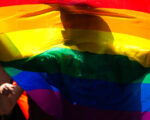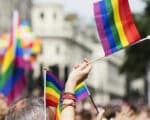>> New study finds that your ‘gaydar’ is terrible
[spacer]
Voilà une nouvelle étude qui replonge dans un débat polémique : peut-on oui ou non déterminer l’orientation sexuelle d’une personne à partir d’une simple observation de son attitude, de sa gestuelle, ou de son apparence?
C’est ce que des chercheurs de l’université de Wisconsin-Madison ont tenté de vérifier, en montrant aux participants des portraits de 55 hommes homosexuels et 50 hommes hétérosexuels piochés dans un site de rencontres, selon le Huffington Post américain qui rapporte cette étude, relayée par slate.fr.
Les photos ont ensuite été associées à des profils que les chercheurs avaient inventés, et qui contenaient des stéréotypes homosexuels (il aime faire du shopping), des stéréotypes hétérosexuels (il aime le football) ou des qualificatifs neutres (il aime la lecture). Résultat: les participants arrivaient beaucoup mieux à deviner si une personne était gay lorsque son profil était associé à des stéréotypes. Ce qui semblerait donc être le principal facteur conduisant les cobayes à «identifier» les personnes gays.
 Influencés par la qualité des photos
Influencés par la qualité des photos
De nombreuses études avaient précédemment prétendu démontrer l’existence de cette «intuition» à deviner si une personne est homosexuelle ou non, comme celle menée en 1987 par Berger, Hank, Rauzi et Simkins, ainsi que d’autres études publiées en 1999, 2008 et 2010. Mais une autre expérience réalisée par ces les chercheurs du Wisconsin indique que la perspicacité des «radars» pourrait en fait dépendre de quelque chose de trivial: la qualité des photos.
Les gays auraient, en effet, tendance à mettre des photos de meilleure qualité sur les sites de rencontre. Comme les tests effectués pour vérifier l’existence du «gaydar» sont pour la plupart basés sur ces photos, William Cox, qui a dirigé l’enquête, postulait qu’il y avait là un biais possible. Postulat vérifié: les participants avaient plus tendance à penser qu’une personne était gay lorsque la photo était de meilleure qualité…
Cette étude ne balaie pas complètement les nombreuses études précédentes sur le sujet, commente une journaliste du Washington Post. Mais elle nous invite en tous cas à être prudent sur les raisons qui permettent aux gens de deviner l’orientation sexuelle des homosexuels. Car il s’agit à l’évidence moins de différences profondes que de stéréotypes auxquels les gens croient et auxquels les candidats des sites de rencontres se conforment eux aussi en partie.
Repéré par Aude Lorriaux
[spacer]
>> A new study suggests that ‘gaydar‘ — the sixth sense by which many insist they can just tell that someone they meet isn’t heterosexual — is bad in two big ways.
For starters, it doesn’t work. But more importantly, the concept of gaydar may be pretty harmful. It may — big surprise here, guys — just be an excuse to revel in harmful stereotypes about LGBTQ people.
In a paper published in the Journal of Sex Research, University of Wisconsin-Madison psychologist William Cox argues that gaydar just isn’t really a thing.
“Imagine that 100 percent of gay men wear pink shirts all the time, and 10 percent of straight men wear pink shirts all the time. Even though all gay men wear pink shirts, there would still be twice as many straight men wearing pink shirts. So, even in this extreme example, people who rely on pink shirts as a stereotypic cue to assume men are gay will be wrong two-thirds of the time,” Cox said in a statement.
Previous studies have come out claiming that gaydar is very real, and perhaps even based on cues as innate as facial shape. So a single study can’t debunk all of those. It’s possible there’s some detectable difference that’s common, if not inherent or universal, in people of different sexual orientations. But in his own team’s studies, Cox found that any facial gaydar people seemed to have could be attributed to something pretty trivial: Photo quality.
Gay men tended to use nicer photos on their dating profiles, and those are the pictures that end up being used in studies like these. People may have thought they were detecting some innate gayness in the pictures they ticked off as non-heterosexual, Cox argues, but they were actually just leaning on stereotypes that told them gay men would present themselves better.
Furthermore, the researchers argue that the concept of gaydar is downright dangerous:
“Most people think of stereotyping as inappropriate,” Cox said in a statement. “But if you’re not calling it ‘stereotyping,’ if you’re giving it this other label and camouflaging it as ‘gaydar,’ it appears to be more socially and personally acceptable.”
Cox and his colleagues tested this by manipulating each subject’s belief in gaydar — priming them to think it was real, priming them to think that it was just a form of stereotyping, and not mentioning gaydar at all in the control group. When subjects were told that gaydar had scientific basis, they were more likely to guess that men with stereotypically “gay” traits were gay. For example, they were more likely to guess that a man was gay after being told that he liked to shop.
And leaning on stereotypes — while obviously harmful to member of marginalized groups — is also inaccurate.
“Consider the statistic that gay men are three times more likely to be alcoholic than straight men,” the study states. “Knowing that strong relationship, would you assume that an alcoholic man was likely gay? We surmise that you would not, because alcoholism is not a common stereotypic trait that is supported and perpetuated by the dominant cultural stereotypes of gay men. When stereotypes guide one’s expectations, however, one falls prey to errors in reasoning.”
And studies have found that stereotypes — even “good” ones, like the high style and grooming stereotypically associated with gay men — are bad for members of marginalized groups. Seemingly positive stereotypes can fly under our radars, masquerading as compliments. But they still create a sense that these people are inherently different, that they’re other. And I probably don’t need to tell you that the results of such thinking are less than great.
So even if the science isn’t out on gaydar, it may be time to start thinking of it as just another stereotyping tool.















